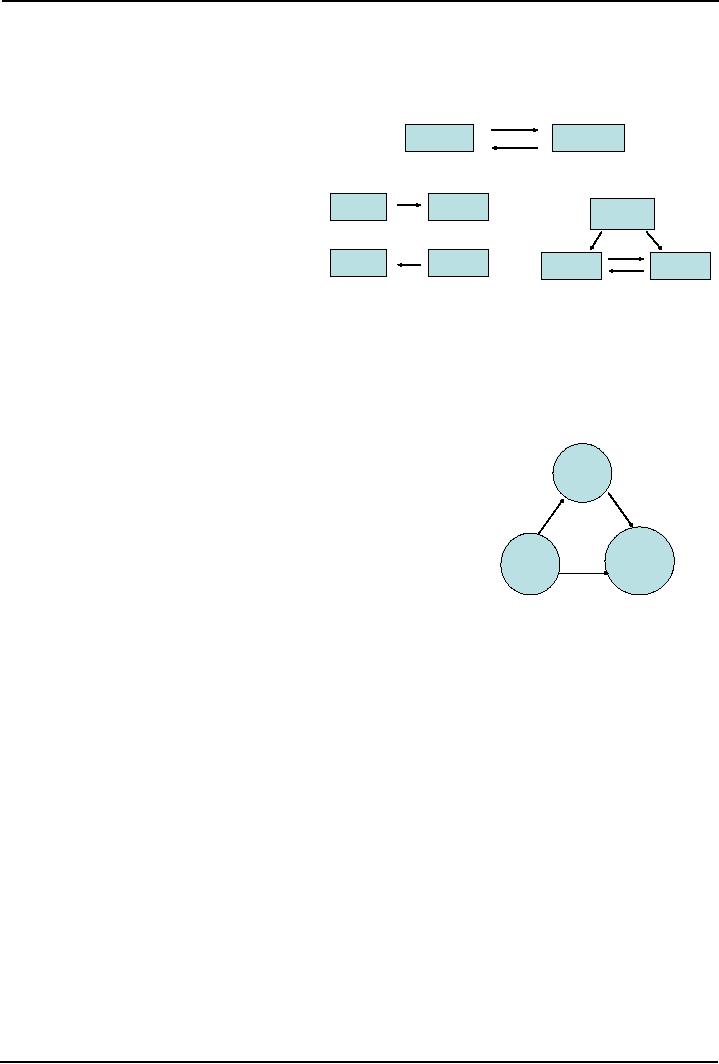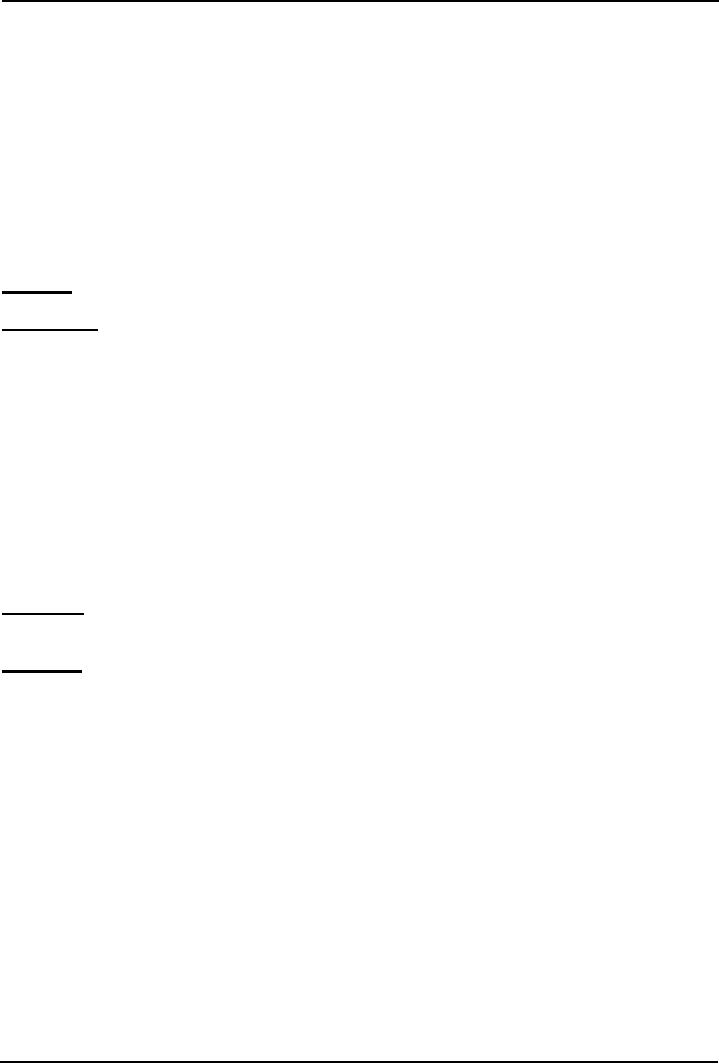 |
CONDUCTING RESEARCH IN SOCIAL PSYCHOLOGY CORRELATIONAL METHOD: |
| << CONDUCTING RESEARCH IN SOCIAL PSYCHOLOGY OBSERVATIONAL METHOD |
| CONDUCTING RESEARCH IN SOCIAL PSYCHOLOGY EXPERIMENTAL METHOD >> |

Social
Psychology (PSY403)
VU
Lesson
07
CONDUCTING
RESEARCH IN SOCIAL
PSYCHOLOGY
CORRELATIONAL
METHOD:
Aims:
To
make students understand how to conduct
social psychology research using
diverse scientific
methodologies.
Objectives:
Describe
correlational research method
Understand
causal and effect
relationships in correlational
research
Discuss
survey method as the most commonly
used method of correlational
research
Understand
designs used in
surveys
Correlational
Research
Besides
describing behavior, social psychologists
are also interested in learning
whether two or more
variables
are related, and if so, how
strongly. When changes in
one variable relate to
changes in another
variable,
we say that they correlate.
Correlational
research assesses the
nature of the relationship between
two
or more variables that are
not controlled by the researcher. In
studying the relationship between
children's
TV viewing habits and their aggressive
behavior, researchers using the
correlational method do
not
try to influence how much
time any of the children in the
study actually spend viewing
violent shows.
Instead,
they merely gather information on the
amount of time the children spend
watching such
programs
and
their degree of aggressive
behavior, and then determine how
these two variables correlate.
A
correlation
assesses the extent to which
two variables covary
Correlation
indicates?
·
Direction
·
Magnitude
of a relationship
The
direction and strength of the relationship between
two variables are described by the
statistical measure
known
as the correlation
coefficient (r).
Strength Basis of
prediction
This
correlation coefficient can range
from -
1.00
to +1.00 (perfect correlations).
Figure 1
D
ire c tio n o f R e la tio n s h ip
demonstrates
positive and negative
relationships,
along with zero or no
relationship.
Figure
1
Correlation
& Causality
Cannot
be used to determine "cause
and
effect"
correlation between being
outgoing
and
satisfied with life;
negative
no
relationship
positive
Two
problems in determining
causality:
·
reverse-causality
problem (aggressive
boys)
·
third-variable
problem: Spurious
relationship
Figure
3: An example of Spurious Relationship
Correlation:
Path Analysis
30

Social
Psychology (PSY403)
VU
A
statistical technique is used to
understand potential causes of
correlational relationships
Figure
4 illustrates the direct
relation
A
n S p u r io u s R e la t io n s h ip
between
parental support and
getting
adjusted
in college, while a
mediating
·
O b s e rv e d c o r re la tio n (+ d ire c t
r
)
variable,
approach coping, is also
indirectly
affecting these two
links.
S
h o e s iz e
M
a th s k ill
Figure
4: Path Analysis
·
S
p u rio u s c a u s a l re la tio n s h
ip
A
c tu a l c a u s a l re la tio n
S
h o e s iz e
M
a th s k ill
A
ge
SURVEYS
Although
studying the
relationships
among
variables can be done by
directly
S
h o e s iz e
M
a th s k ill
S
h o e s iz e
M
a th s k ill
observing
behavior or examining
archived
information,
it is often accomplished by
asking
people carefully
constructed
questions.
Surveys
are
structured sets of questions or statements
given to a group of people to
measure
their
attitudes, beliefs, values, or behavioral
tendencies (Lavrakas, 1993;
Schuman, 2002).
The
four
major
survey
techniques
are face-to-face
surveys,
C
o rre la tio n : P a th A n a lys
is
written
surveys, phone surveys, and
computer
surveys. The
face-to-face
format
provides highly
detailed
·
A statis tical tec hniq u
e
M
ediator
information
and allows researchers
the
Approach
use
d to u n de rs ta n d
coping
best
opportunity to clarify any
unclear
pote
ntia l ca us es of
Path
C
questions.
However, it is costly
and
corre
lation al
Path
B
there
is always the possibility
that
relations
hips
people's
responses might be
influenced
Change
in
Parental
by
the interviewer's presence.
Written,
adjustment
Support
in
college
phone,
and computer surveys eliminate
such
interviewer bias and are
much less
Path
A
expensive.
(direct)
An
important consideration in
V
alentiner et al.,
1994
constructing
surveys involves
how
questions
are asked. Survey questions
usually are either open-ended or
closed-ended.
An
open-ended
question requires a
response that must have more
than just a yes or no
answer--
research
participants provide a narrative
response. A closed-ended
question, in contrast, is
answered with a
yes
or no, or by choosing a single response
from several alternatives. Closed-ended questions
are the
quickest
and easiest to score. In contrast, open-ended
questions may provide information
from respondents
that
might be missed with closed-ended
questions. However, open-ended responses
require coding by
carefully
trained judges and this is a
time-consuming process.
One
of the most important considerations in
conducting surveys--as well as
when using other
methods--is
getting responses from
people who represent the
population as a whole. This
representative
sample
is
often obtained through
random
selection, which is a
procedure in which everyone in the
population
has an equal chance of being
selected for the sample. As
long as a sample is selected
randomly,
you
are reasonably assured that the
data will represent the
overall population. However,
when samples are
not
randomly selected, drawing conclusions
from the data can lead to
serious errors.
Finally,
one last problem in conducting survey
research is social
desirability bias, which
occurs
when
people respond to survey questions by
trying to portray them in a favorable
light rather than
responding
in an accurate and truthful
manner
Surveys
are
structured sets of questions or statements
given to a group of people to
measure their
attitudes,
beliefs,
values, or behavioral tendencies
31

Social
Psychology (PSY403)
VU
Types
of surveys:
·
Face-to-face
surveys
·
Written
surveys
·
Phone
surveys
·
Computer
surveys.
Questions
in Surveys
Types
of questions:
·
Closed-ended
questions
·
Open-ended
questions
Examples
Closed-ended:
Do
you enjoy chatting
online?
Response:
Yes_____ No______
-How
much you enjoy chatting
online?
Likert
Scales:
Birth
control should be absolutely
prohibited?
Strongly
disagree
strongly
agree
1
2
3
4
5
2.
Birth
control is a legitimate health
measure?
Strongly
disagree
strongly
agree
1
2
3
4
5
Social
Psychology-Lecture 2: e.g., Likert
Scale
Open-ended:
Why do you like (or
not enjoy) chatting
online?
Response
____________________________
Conclusion:
Usually researchers attempt to utilize
the strengths of both types; providing
some alternatives,
and
also giving opportunity to
write response of their own
choice.
Schuman
et al conducted a survey in USA to
identify the most important problems
faced by the country;
from
responses, they chose 4 problems
only chosen by less than 3%
of population; in another survey
they
provided
these four problems with an open-ended
choice; 60% selected one of
the rare problems;
concluded
that respondents may not
brain storm, are lazy, and
take survey causally.
Order
& format of Questionnaires
·
Start
with easy, salient and
nonthreatening questions
·
Avoid
beginning with demographic and open-ended
questionnaire
·
Funneling
procedure: start with more general and
move to more specific questions
·
Where
appropriate, follow a chronological
order, e.g., in job dates,
case histories, etc.
·
Only
use `filter' questions when
unavoidable: Only use
`filter' questions (e.g., if yes, go to
31, if
no,
to 14) when unavoidable: it is
likely that respondent may
answer in such a way as to
reduce the
total
number of questions.
·
Avoid
using double negatives.
·
In
face-to-face interviews, provide cards to
show the scale
32

Social
Psychology (PSY403)
VU
Threatening
Questions
How
to ask? "Did you kill your
wife" (Barton,
1958)
1.
The casual approach
"Do
you happen to have murdered your
wife"
2.
The numbered card
Would
you please tick the number on
this card which corresponds
to what happened to your
wife?
The
natural death
I
killed her
Other
(what?)
3.
The everyday approach
"As
you know many people have
been killing their wives
these days. Do you happen to have
killed yours?"
4.
The other people
approach
Do
you know any people
who have murdered their
wives?
How
about yourself?
5.
The Kinsey
technique
Stare
firmly into respondents and
ask in a matter of fact
way:
"Did
you ever kill your
wife?"
Remember
to put such question at the
end of the interview
Important
considerations in conducting
surveys
·
Representative
sample obtained
through random
selection
·
Social
desirability bias should be
minimized: Social desirability bias,
which occurs when
people
respond
to survey questions by trying to portray
themselves in a favorable light rather
than
responding
in an accurate and truthful
manner
Designs
in Surveys
Survey
research is carried out
according to an overall plan - a
research design
1.
Cross-sectional
design: In Cross-sectional
designs, one or more samples are
drawn at one point in
time;
e.g., groups of different ages
2.
Longitudinal design
·
Trend
studies/ Successive
samples: Different samples of
respondents from the
population
complete
the survey over a time
period; they do not allow
researcher to study changes in
a
population
over time. A problem occurs
when the samples drawn are
not comparable;
change
in values of students, whether
contemporary citizens are more informed
than
citizens
of an earlier generation.
·
Cohorts
studies (usually
age group) typically, a
cohort is an age group, but
may refer to
other
groups also, like people who
got married during
1940.
·
Panel
studies: the same respondents are
surveyed over time (at
several points in time) in
order
to examine changes in individual
respondents; within subject variability
is reduced;
Practice
effect and drop outs
are there. Moreover, if time
points are more, then it is
a
massive
effort
Estimating
sample size in surveys:
Figure
5 indicates
that 2 considerations shall be in
mind while deciding about
number of people in one
survey:
33

Social
Psychology (PSY403)
VU
1.
Work-out number of variables: 4
here
2.
Establish minimum cell
size
E
s tim a tin g s a m p le s iz e r e q u ir e
d
M
a le
F
e m a le
M
a r ita l
W
o r k in g
U
n e m p l.
W
o r k in g
U
n e m p l.
S
ta tu s
Age
10
10
10
10
<
20
10
10
10
10
2
1 -4 0
10
10
10
10
M
a r r ie d
4
1 -6 0
10
10
10
10
60+
<
20
10
10
10
10
2
1 -4 0
10
10
10
10
N
ot
m
a r r ie d
4
1 -6 0
10
10
10
10
60+
10
10
10
10
T
o ta l R e q u ir e d = 2 x 2 x 2 x 4 = 3 2 x 1 0 = 3
2 0
34
Table of Contents:
- INTRODUCTION TO SOCIAL PSYCHOLOGY:Readings, Main Elements of Definitions
- INTRODUCTION TO SOCIAL PSYCHOLOGY:Social Psychology and Sociology
- CONDUCTING RESEARCH IN SOCIAL PSYCHOLOGY:Scientific Method
- CONDUCTING RESEARCH IN SOCIAL PSYCHOLOGY:Evaluate Ethics
- CONDUCTING RESEARCH IN SOCIAL PSYCHOLOGY RESEARCH PROCESS, DESIGNS AND METHODS (CONTINUED)
- CONDUCTING RESEARCH IN SOCIAL PSYCHOLOGY OBSERVATIONAL METHOD
- CONDUCTING RESEARCH IN SOCIAL PSYCHOLOGY CORRELATIONAL METHOD:
- CONDUCTING RESEARCH IN SOCIAL PSYCHOLOGY EXPERIMENTAL METHOD
- THE SELF:Meta Analysis, THE INTERNET, BRAIN-IMAGING TECHNIQUES
- THE SELF (CONTINUED):Development of Self awareness, SELF REGULATION
- THE SELF (CONTINUE…….):Journal Activity, POSSIBLE HISTORICAL EFFECTS
- THE SELF (CONTINUE……….):SELF-SCHEMAS, SELF-COMPLEXITY
- PERSON PERCEPTION:Impression Formation, Facial Expressions
- PERSON PERCEPTION (CONTINUE…..):GENDER SOCIALIZATION, Integrating Impressions
- PERSON PERCEPTION: WHEN PERSON PERCEPTION IS MOST CHALLENGING
- ATTRIBUTION:The locus of causality, Stability & Controllability
- ATTRIBUTION ERRORS:Biases in Attribution, Cultural differences
- SOCIAL COGNITION:We are categorizing creatures, Developing Schemas
- SOCIAL COGNITION (CONTINUE…….):Counterfactual Thinking, Confirmation bias
- ATTITUDES:Affective component, Behavioral component, Cognitive component
- ATTITUDE FORMATION:Classical conditioning, Subliminal conditioning
- ATTITUDE AND BEHAVIOR:Theory of planned behavior, Attitude strength
- ATTITUDE CHANGE:Factors affecting dissonance, Likeability
- ATTITUDE CHANGE (CONTINUE……….):Attitudinal Inoculation, Audience Variables
- PREJUDICE AND DISCRIMINATION:Activity on Cognitive Dissonance, Categorization
- PREJUDICE AND DISCRIMINATION (CONTINUE……….):Religion, Stereotype threat
- REDUCING PREJUDICE AND DISCRIMINATION:The contact hypothesis
- INTERPERSONAL ATTRACTION:Reasons for affiliation, Theory of Social exchange
- INTERPERSONAL ATTRACTION (CONTINUE……..):Physical attractiveness
- INTIMATE RELATIONSHIPS:Applied Social Psychology Lab
- SOCIAL INFLUENCE:Attachment styles & Friendship, SOCIAL INTERACTIONS
- SOCIAL INFLUENCE (CONTINE………):Normative influence, Informational influence
- SOCIAL INFLUENCE (CONTINUE……):Crimes of Obedience, Predictions
- AGGRESSION:Identifying Aggression, Instrumental aggression
- AGGRESSION (CONTINUE……):The Cognitive-Neo-associationist Model
- REDUCING AGGRESSION:Punishment, Incompatible response strategy
- PROSOCIAL BEHAVIOR:Types of Helping, Reciprocal helping, Norm of responsibility
- PROSOCIAL BEHAVIOR (CONTINUE………):Bystander Intervention, Diffusion of responsibility
- GROUP BEHAVIOR:Applied Social Psychology Lab, Basic Features of Groups
- GROUP BEHAVIOR (CONTINUE…………):Social Loafing, Deindividuation
- up Decision GROUP BEHAVIOR (CONTINUE……….):GroProcess, Group Polarization
- INTERPERSONAL POWER: LEADERSHIP, The Situational Perspective, Information power
- SOCIAL PSYCHOLOGY APPLIED: SOCIAL PSYCHOLOGY IN COURT
- SOCIAL PSYCHOLOGY APPLIED: SOCIAL PSYCHOLOGY IN CLINIC
- FINAL REVIEW:Social Psychology and related fields, History, Social cognition